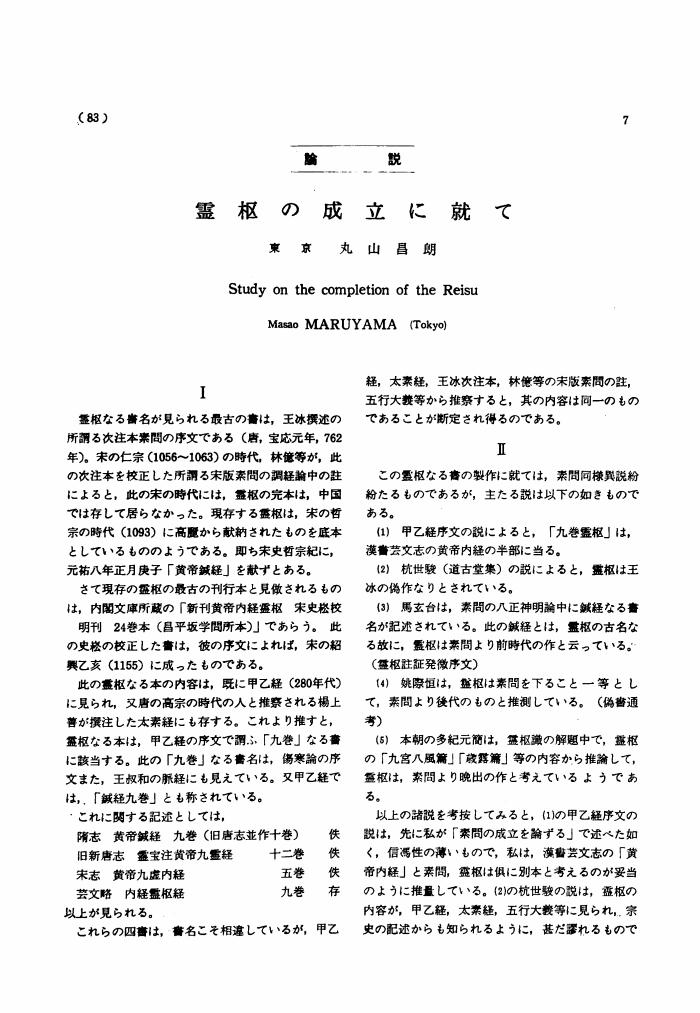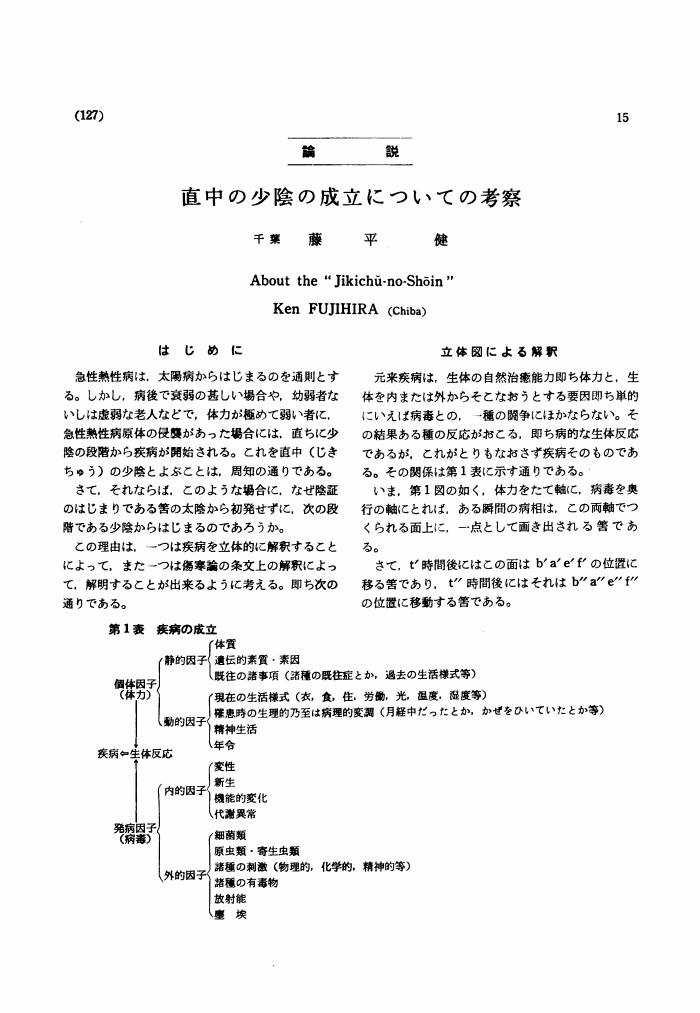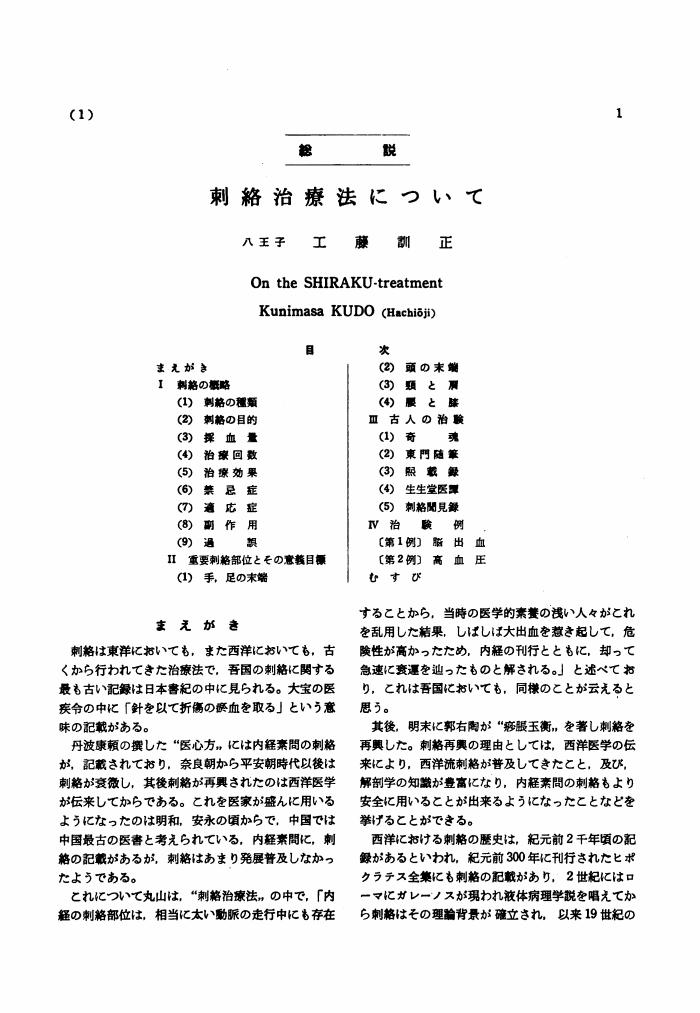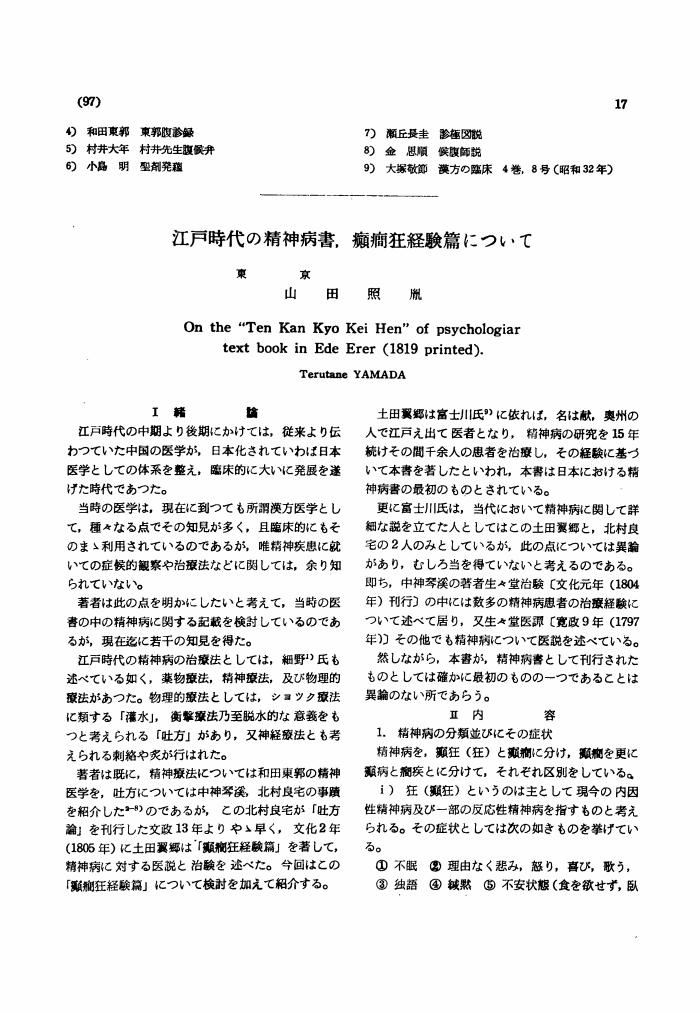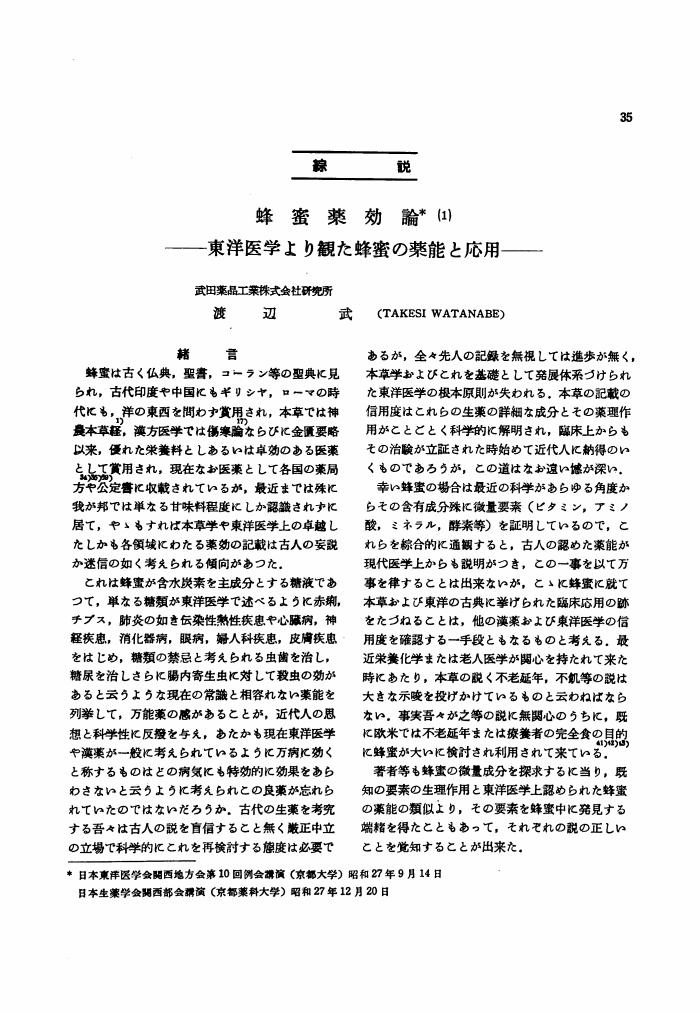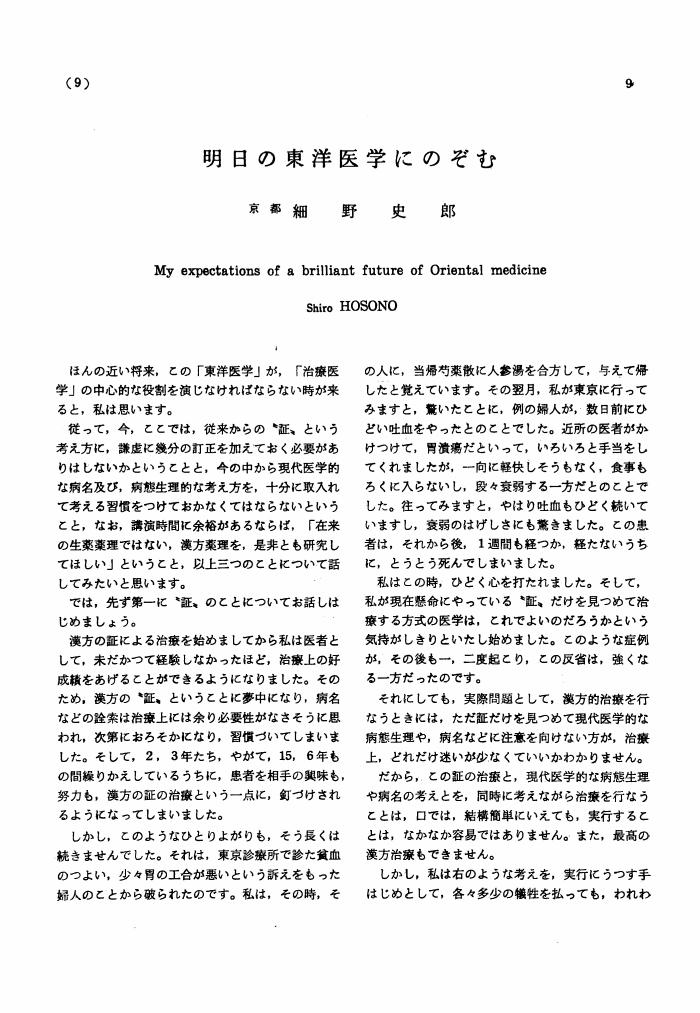8 0 0 0 OA 霊枢の成立に就て
- 著者
- 丸山 昌朗
- 出版者
- The Japan Society for Oriental Medicine
- 雑誌
- 日本東洋醫學會誌 (ISSN:1884202X)
- 巻号頁・発行日
- vol.15, no.3, pp.83-88, 1965-03-20 (Released:2010-10-21)
- 参考文献数
- 4
6 0 0 0 OA 直中の少陰の成立についての考察
- 著者
- 藤平 健
- 出版者
- The Japan Society for Oriental Medicine
- 雑誌
- 日本東洋醫學會誌 (ISSN:1884202X)
- 巻号頁・発行日
- vol.16, no.3, pp.127-129, 1966-01-31 (Released:2010-10-21)
6 0 0 0 OA 除中と虚熱
- 著者
- 藤平 健
- 出版者
- The Japan Society for Oriental Medicine
- 雑誌
- 日本東洋醫學會誌 (ISSN:1884202X)
- 巻号頁・発行日
- vol.22, no.1, pp.14-16, 1971-08-30 (Released:2010-10-21)
5 0 0 0 OA 新しい灸学と其應用
- 著者
- 原 志免太郎
- 出版者
- 一般社団法人 日本東洋医学会
- 雑誌
- 日本東洋醫學會誌 (ISSN:1884202X)
- 巻号頁・発行日
- vol.4, no.1, pp.42-44, 1953-05-25 (Released:2010-10-21)
5 0 0 0 OA 刺絡治療法について
- 著者
- 工藤 訓正
- 出版者
- The Japan Society for Oriental Medicine
- 雑誌
- 日本東洋醫學會誌 (ISSN:1884202X)
- 巻号頁・発行日
- vol.16, no.1, pp.1-8, 1965-07-30 (Released:2010-10-21)
5 0 0 0 OA 妊娠及び分娩に対する三陰交施灸の効果
- 著者
- 石野 信安
- 出版者
- The Japan Society for Oriental Medicine
- 雑誌
- 日本東洋醫學會誌 (ISSN:1884202X)
- 巻号頁・発行日
- vol.10, no.1, pp.22-24, 1959-07-30 (Released:2010-10-21)
- 参考文献数
- 4
5 0 0 0 OA 江戸時代の精神病書, 癲癇狂経験篇について
- 著者
- 山田 照胤
- 出版者
- The Japan Society for Oriental Medicine
- 雑誌
- 日本東洋醫學會誌 (ISSN:1884202X)
- 巻号頁・発行日
- vol.8, no.3, pp.97-100, 1957-12-31 (Released:2010-10-21)
- 参考文献数
- 9
5 0 0 0 OA 腹診考 (1)
- 著者
- 大塚 敬節
- 出版者
- The Japan Society for Oriental Medicine
- 雑誌
- 日本東洋醫學會誌 (ISSN:1884202X)
- 巻号頁・発行日
- vol.11, no.1, pp.13-17, 1960-06-30 (Released:2010-10-21)
4 0 0 0 OA 蜂蜜薬効論 東洋医学より観た蜂蜜の薬能と応用
- 著者
- 渡辺 武
- 出版者
- 一般社団法人 日本東洋医学会
- 雑誌
- 日本東洋醫學會誌 (ISSN:1884202X)
- 巻号頁・発行日
- vol.5, no.2, pp.35-41, 1954-11-15 (Released:2010-10-21)
- 参考文献数
- 69
4 0 0 0 OA 明日の東洋医学にのぞむ
- 著者
- 細野 史郎
- 出版者
- The Japan Society for Oriental Medicine
- 雑誌
- 日本東洋醫學會誌 (ISSN:1884202X)
- 巻号頁・発行日
- vol.25, no.1, pp.9-18, 1974-09-10 (Released:2010-10-21)
4 0 0 0 OA 於血をめぐって
- 著者
- 矢数 道明
- 出版者
- The Japan Society for Oriental Medicine
- 雑誌
- 日本東洋醫學會誌 (ISSN:1884202X)
- 巻号頁・発行日
- vol.25, no.4, pp.165-185, 1975-06-30 (Released:2010-10-21)
- 参考文献数
- 21
In Oriental medicine diseases have been explained as the products of Oketsu, Suidoku or Shokudoku. Oketsu means the stagnation of disordered blood, which should appear in various febrile diseases, women in childbed, contusions and individuals of hereditarily idiosyncratic constitution. Suidoku means intoxication caused by disturbances of water metabolism, while Shokudoku means intestinal autointoxication caused by unbalanced diet. Each of these three factors causes in its turn various specific diseases respectively.In “Shang han lun” and “Chin kuei yao lüeh” (217 A. D.) of Chang Chung-ching are given many formulas for combatting Oketsu, Suidoku and Shokudoku, and they have been used successfully.There are some different principles of healing Oketsu, namely; to bring disordered blood circulation into normal condition, to restore disordered blood and remove the stagnation, and to dissolve blood clots to normalize blood circulation.In the last case of the above three various drugs of animal origine are used in combination with those of vegetable origin. They are, for instance, leeches, gadflies, opisthoplatia orientalis, larvae of coprides species and others. It is interesting that worn-out dish rags and dirty straw mats were used as remedies for contusions. The animals providing such drugs live mainly in dirty mud or decomposed matter, that is; they are resistant to dirty or decomposed environment. The others such as leeches or gadflies contain anticoagulant substances.Throughout the history of Oriental medicine so called “sympathetic drugs” have been used, which share the thought of “Similia similibus curantur” with Homöopathy.A series of studies by Dr. Knisely and others in the last 40 years or so on “Sludged blood”, coagulation of red blood cells in blood vessels, seems to provide some available explanations of Oketsu. A new way of healing diseases with blood coagulation could be found out through clinical studies of Oketsu on the basis of the traditional context of Oriental medicine.
3 0 0 0 OA 附子の毒力・効力に関する諸問題
3 0 0 0 OA 免疫機構におよぼす針灸の効果
- 著者
- 五十嵐 宏 丹野 恭夫 光藤 英彦 代田 文彦
- 出版者
- The Japan Society for Oriental Medicine
- 雑誌
- 日本東洋醫學會誌 (ISSN:1884202X)
- 巻号頁・発行日
- vol.26, no.2, pp.117-121, 1975-12-30 (Released:2010-10-21)
- 参考文献数
- 7
3 0 0 0 OA 胸脇苦満を語る (I)
- 著者
- 細野 史郎
- 出版者
- The Japan Society for Oriental Medicine
- 雑誌
- 日本東洋醫學會誌 (ISSN:1884202X)
- 巻号頁・発行日
- vol.16, no.2, pp.63-75, 1965-10-30 (Released:2010-10-21)
3 0 0 0 OA 腹診考 (2)
- 著者
- 大塚 敬節
- 出版者
- The Japan Society for Oriental Medicine
- 雑誌
- 日本東洋醫學會誌 (ISSN:1884202X)
- 巻号頁・発行日
- vol.11, no.2, pp.74-78, 1960-09-30 (Released:2010-10-21)
3 0 0 0 OA 疝気症候群A型の提唱
- 著者
- 大塚 敬節
- 出版者
- The Japan Society for Oriental Medicine
- 雑誌
- 日本東洋醫學會誌 (ISSN:1884202X)
- 巻号頁・発行日
- vol.25, no.1, pp.19-23, 1974-09-10 (Released:2010-10-21)
2 0 0 0 OA 附子の医史学的考察 (古代・中世)
- 著者
- 大塚 恭男
- 出版者
- The Japan Society for Oriental Medicine
- 雑誌
- 日本東洋醫學會誌 (ISSN:1884202X)
- 巻号頁・発行日
- vol.19, no.2, pp.62-71, 1968-09-30 (Released:2010-10-21)
- 参考文献数
- 68
2 0 0 0 OA 「傷寒論」の治療諸原則について
- 著者
- 藤平 健
- 出版者
- The Japan Society for Oriental Medicine
- 雑誌
- 日本東洋醫學會誌 (ISSN:1884202X)
- 巻号頁・発行日
- vol.28, no.1, pp.1-12, 1977-11-30 (Released:2010-10-21)
2 0 0 0 OA 解肌について
- 著者
- 藤平 健
- 出版者
- The Japan Society for Oriental Medicine
- 雑誌
- 日本東洋醫學會誌 (ISSN:1884202X)
- 巻号頁・発行日
- vol.24, no.3, pp.438-440, 1974-03-30 (Released:2010-11-29)
2 0 0 0 OA 中国医学古典にもとつく鍼灸治療の基礎的体系
- 著者
- 柴崎 保三
- 出版者
- The Japan Society for Oriental Medicine
- 雑誌
- 日本東洋醫學會誌 (ISSN:1884202X)
- 巻号頁・発行日
- vol.24, no.2, pp.396-404, 1973-12-10 (Released:2010-10-21)
